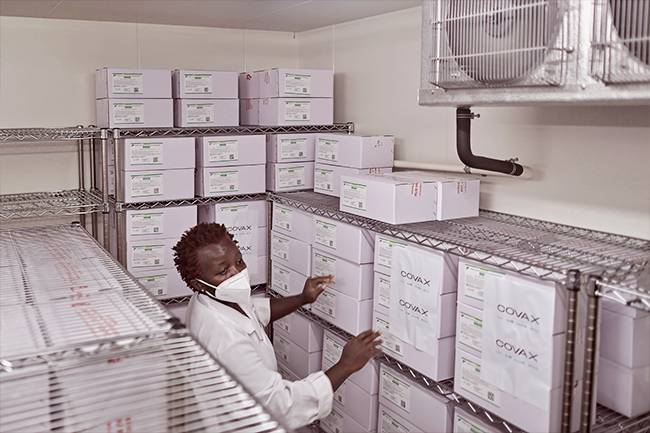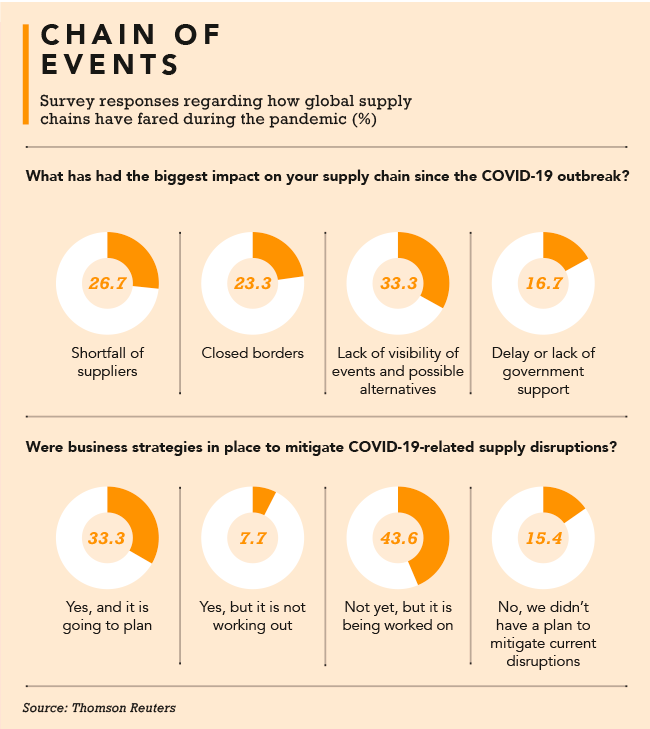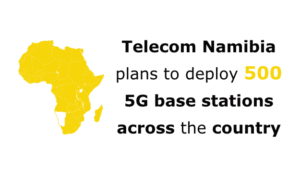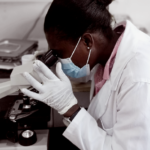Moderna’s COVID-19 vaccine must be stored at temperatures between -25°C and -15°C. AstraZeneca’s, meanwhile, stays good at about 2°C to 8° C, while Pfizer’s needs to be kept at about -13°C. If they get any warmer than that on the journey from the factory laboratory to your arm, their messenger RNAs start to break down. The vaccines – like milk or mushrooms – go bad if the ‘cold chain’ is broken.
It’s tough enough to maintain that cold chain between the port and where you are if you live in one of Africa’s major coastal metros (Lagos, say, or Accra, Cape Town or Mombasa); but what if you live in a remote village in, for example, the DRC’s Équateur province, which saw an Ebola virus outbreak in 2018? Getting to some parts of Équateur can take hours, with part of the journey on a non-motorised riverboat.
Whether it’s the coronavirus or other emergencies (economic or health-related), the COVID-19 crisis has placed Africa’s supply chains under the microscope. The PPE that came in from overseas; the manufacturing parts that sat in port for weeks on end; the groceries (and toilet paper!) that didn’t reach your local store; the international post that got locked down in big warehouses… ‘Virtually everything that we use or touch every day has reached us through supply chains,’ says Richard dos Santos, a director at the Professional Body for Supply Chain Management (SAPICS).
‘This pandemic has highlighted the importance of supply chains to everyone. ‘They connect everything and really do make our societies and economies function, and this has never been more visibly apparent than it has been during the COVID-19 pandemic. Supply chains and effective supply-chain management have the power to not only ensure the smooth flow of goods and services from the point of origin to the point of consumption, but [also] to save lives, to save the planet and ensure brighter futures for individuals, organisations and communities.’

At the same time, though, supply chains are to the global economy as an appendix is to the human body: you only notice it when something goes wrong… And then you certainly do notice it. As the New York Times puts it, ‘the virus has thrown off the choreography of moving cargo from one continent to another’. Lars Mikael Jensen, head of Global Ocean Network at shipping giant AP Moller-Maersk, sums it up even better, telling the publication that he has ‘never seen anything like this. All the links in the supply chain are stretched. The ships, the trucks, the warehouses’.
Yet the crisis has also brought a significant opportunity. In May 2020, at the height of South Africa’s hard lockdown, Heinrich de Leeuw, MD at tech firm Seidor South Africa, posed the question in an op-ed piece as to whether ‘the global coronavirus pandemic [could] be the black swan event that forces companies, and entire industry sectors, to rethink and transform their supply-chain models’.
De Leeuw noted that while the full impact of COVID-19 on supply chains remained unknown then (and, nearly a year on, still does), ‘what we do know is that the economic and financial ramifications will be felt across global supply chains. There is no doubt that the ongoing digital transformation of industries will be accelerated as a result of the current crisis’.
He argued that emerging technologies held the answer. ‘Right now, supply chain leaders would be wise to quickly change how they do things if they want to overcome the challenges that arise from lack of visibility, collaboration and co-ordination,’ he wrote. ‘The need for more automation and information is an opportunity for manufacturers. In the wake of COVID-19, companies still need human workers to manage the supply chain, but they also need to evolve their businesses into digitally intelligent organisations that are equipped to drive efficiencies throughout their business processes.’
Of course, most supply chains – whether in retail, manufacturing or healthcare – have always had contingency plans built in. But many of those measures proved powerless when COVID-19 struck. ‘The absolute state of paralysis that still exists across supply chains months after the start of the pandemic is forcing organisations to not only rethink how they’re managing their supply chains, but also to re-assess the skills and data sets needed to effectively handle disruptions,’ Kavitha Prag, digital supply network and operations lead at Deloitte Consulting Africa, told CIO in late 2020.
A recent Deloitte report on managing supply-chain risk and disruption amid COVID-19 highlights how some businesses were well prepared to respond to the pandemic. Others? Not so much. ‘These companies are overly reliant on a single geography or a single supplier for key products,’ according to the report. ‘They don’t have enough visibility across the extended supply network to see their risks. They do not have the systems to understand their inventory status, to project stock-outs of direct materials and optimise production, or to project stock-outs of finished goods to optimise customer allocation, and they don’t have flexible logistics networks to ensure the flow of goods in a profitable manner.’

Like Seidor’s De Leeuw, many African business leaders see this crisis as an opportunity to rethink supply chains – especially in the context of the African Continental Free Trade Area agreement, which launched in January 2020. Nicolette Skjoldhammer, MD of South African steel fabricator Betterect, is one of them. ‘While the new intra-African trade agreement provides opportunities and incentives for African stakeholders to procure from local businesses, the effects of the COVID-19 pandemic have shown industry just how dependent Africa has become on the Asian supply of goods and services, and prices of Asian consumables – to name but one supply chain item among many – are rising exponentially,’ she says.
Skjoldhammer suggests that companies within the same industry work together to deliver collaborative solutions. Taking an example from her own industry, she sees companies that focus on the supply, processing, fabrication and erection of steel structures joining forces to deliver pan-African infrastructure projects in the mining, power generation, petrochemical and other industries. ‘These companies are able to form a co-operative and synergistic “Team Africa” that supplies and processes the steel, or fabricates and installs the finished steel structures,’ she says. It may seem a panacea, but Skjoldhammer does indeed have a point. ‘South Africa and its counterparts, like Nigeria and Ghana, certainly have the expertise to successfully undertake the design, fabrication and installation of large steel structures throughout the continent,’ she says. ‘We have not only proven this over years of successfully participating in new and expansionary mining, power-generation and other infrastructure projects; but also by supplying the core expertise in large structural-steel projects under the auspices of European and Asian companies.’
SAPICS’ Dos Santos, meanwhile, is encouraged by the potential influx of new ideas, new talent and new technologies into the supply-chain field. ‘Historically, we have not seen the largest groundswell of school leavers making supply chain a field of choice to study within. Until now, the profession was not attracting the young, emerging talent that it needed. A lot of this has to do with marketing and awareness,’ he says. ‘This crisis is changing perceptions of the profession and increasing understanding of the valuable role it plays. With cutting-edge and attractive technologies like AI, robots and drones increasingly being leveraged to optimise supply chains and logistics – and to enhance safety during the pandemic – supply-chain management is being seen as a sexy profession of choice.’
While Skjoldhammer’s ‘Team Africa’ represents an innovative way of thinking that might take time to realise, one emerging technology is already helping to solve Africa’s supply-chain challenges. In October 2020 Freddy Nkosi, DRC country director for healthcare NPO VillageReach, told a SAPICS virtual conference about how aerial drones are getting vaccines and supplies into Africa’s hard-to-reach rural communities. The Drones for Health project is being piloted in, of all places, Équateur. ‘This is a province with many geographical challenges,’ said Nkosi. ‘It has 18 health districts, more than half of which are only accessible by river. This makes the supply chain and transportation of vaccines from the provincial storage to the remote health storage facilities exceedingly difficult, especially during the rainy season when there is often flooding.’
Yet while a round trip to Équateur can take up to six hours, Nkosi said that VillageReach’s drone fleet can complete the one-way journey in just 20 minutes.
Impressive? Yes. Scalable? It’s too early to tell. But while COVID-19 vaccines continue to travel along Africa’s delicate, disrupted supply chains, any innovation that offers a sustainable solution is one worth listening to.
















